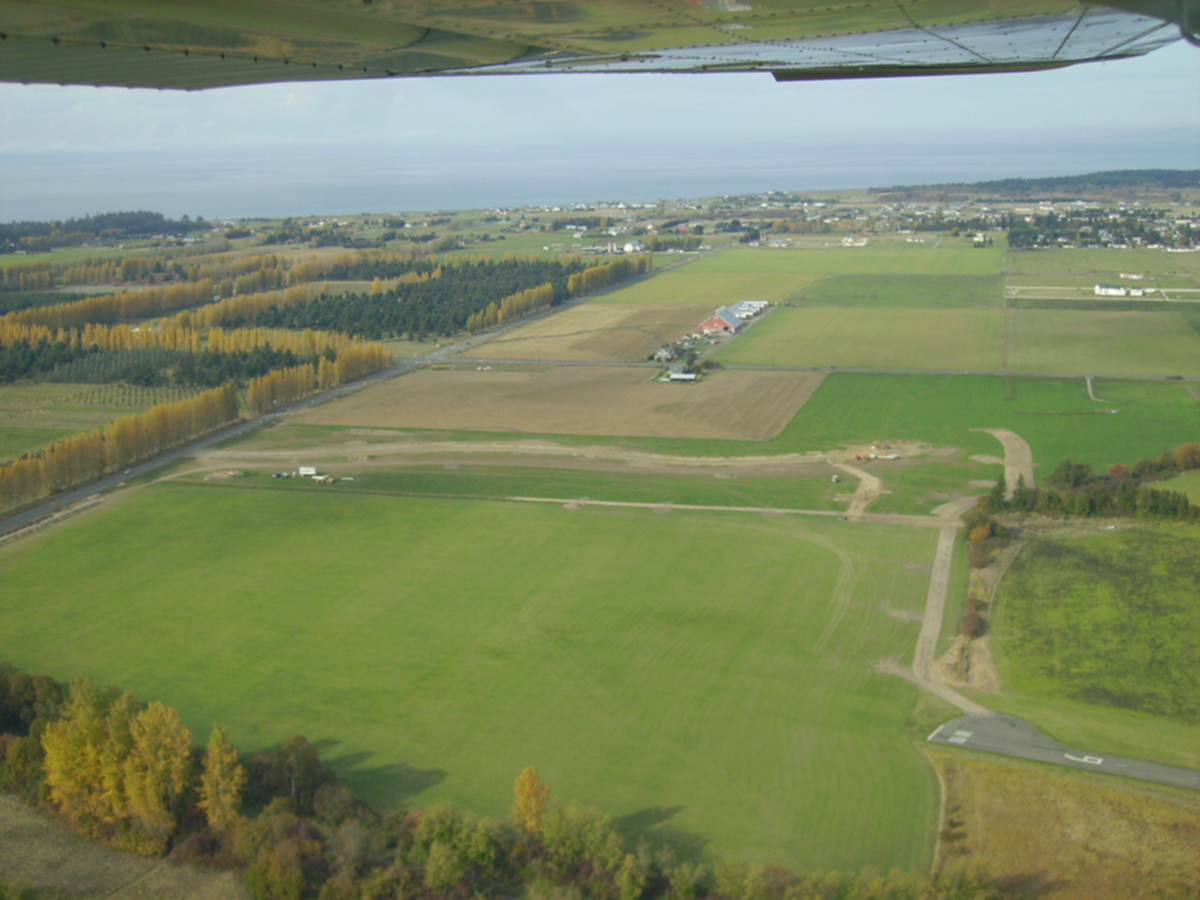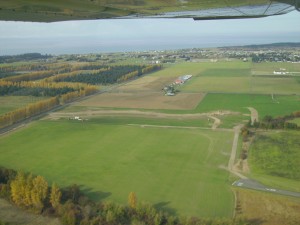
Looking north toward the Strait of Juan de Fuca, Discovery Trail Farm is in the foreground, with 30 acres at the end of the runway, at lower right. Home sites are along the entrance road to the development.
By Terry Stephens
Home developer Dave LeRoux hasn’t flown for 20 years, but he still knows what pilots want in an airpark—large open home sites, a lighted runway and protection from future encroaching development. That’s why his Discovery Trail Farm at Sequim, on Washington’s scenic Olympic Peninsula, will be unique among the more than 400 airparks scattered across the United States.
“Many that started out in rural areas are facing new housing developments close by, infringing on open space and creating problems, because new residents outside the airpark don’t necessarily want airplanes for neighbors,” LeRoux said. “That won’t be a problem with this airpark.”
It took him several years, and the patience to get through more than 20 different permits, but LeRoux has created a development that satisfies everyone. Adjacent Sequim Valley Airport (W28) will benefit financially and is helping promote the airpark. Farmland protection groups will see acreage preserved. Local architects and contractors will design and build the homes. Pilots will like the protected home sites, the taxiway to the adjacent airport and the 30 acres of open land that will always be at the end of the runway.”
LeRoux said he and partner Walter Johnson started out by planning the development of 65 acres of farmland.
“We restricted it to 13 clustered homesites of around one acre each,” said LeRoux. “Each of the owners will have plenty of room for a home, garage and hangar. They’ll also get more than 50 acres of open fields that someone else mows, plus spectacular panoramic views of the 6,000-to-8,000-foot Olympic Mountains to the south and Puget Sound’s Straits of Juan DeFuca to the north.”
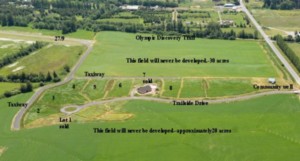
The highway entrance to the Discovery Trail Farm airpark, at right, leads to eight development sites. The taxiway connects with the runway of Sequim Valley Airport, at upper left. Fifty acres of land around the airpark will never be developed.
The 50 acres of farmland surrounding Discovery Trail Farm are under the conservation protection of the North Olympic Land Trust, managed by Allison Lutz, who said the agreement will keep that land undeveloped forever. Neighboring farmers will continue to grow Brussels sprouts, cabbage and hay. A hedgerow surrounds the property, forming a wildlife corridor, LeRoux said, and a trail connects the home sites to the nearby Olympic Discovery Trail that winds for miles from Sequim to Port Angeles.
“I’ve read too many stories over the years about airports and airparks being squeezed by land development around them,” said LeRoux, a Michigan native with a master’s degree in public health from the University of Washington. “I wanted to do something different and saw the opportunity. We built a taxiway from the development to the adjacent airport’s runway, which is a lighted, 3,500-foot paved strip. Airplanes don’t have to share the taxiway with cars, as they do in other airparks. This is a rare, progressive development that will appeal to people who fly.”
For pilots, the attraction isn’t only the preserved space and easy airport access, but also the 300 or so days of sunshine in the area—weather that has made Sequim a popular retirement town for those who don’t fly.
Of the 13 home sites offered, eight went on the market in the first phase, and two have already sold. They’re pricey, LeRoux admits, but affordable for the limited market he’s targeting: people with their own planes who want the ease of flying with the conveniences of country living.
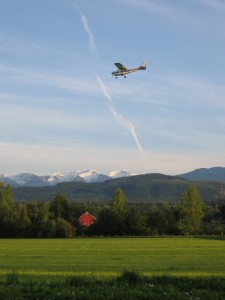
A Cessna on final approach offers a spectacular view of the Olympic Mountains as it passes over Sequim’s Discovery Trail Farm airpark.
Sites are priced at $330,000 to $355,000, but a quarter of the price goes to the airport for perpetual access to the runway and facilities. LeRoux worked out that creative angle with the owners.
“Small private airports have limited ways to raise money and need revenue sources,” he said. “We made an agreement with the owners, primarily the Sallee family and a few other stockholders, for access to the field. Out of a $330,000 site sale, $82,500 goes to the airport.”
It will add up to more than $1 million for the airport when all 13 lots sell.
Sequim Valley Airport, which began development in 1983, offers a quality aviation facility for the North Olympic Peninsula area. Privately owned, with public access, the facility provides fuel, flight instruction and mechanic services, as well as air freight, charter flights, skydiving and aircraft rentals. Twenty-eight aircraft are based at the airport, frequently visited by recreation and business pilots as well.
Sequim Valley Aircraft Maintenance provides service for single and twin-engine aircraft, including inspections and engine installations. From the airport, Boeing Field is only 53 nautical miles away; Portland is 152; the San Juan Islands are 24; and Victoria, British Columbia, Canada, is 24 miles to the north.
The airport’s founder, Jack Sallee, was a jet fighter pilot who later flew for Braniff International, retiring as a 747 captain. Since his death in a 1997 industrial accident, his wife Winnie and their four sons have operated the airport. Andrew lives in Sequim and is a 727 captain for Astar Air Cargo. Joe’s an A320 captain for JetBlue Airways, lives in Florida and spends summers in Sequim. William, who lives in Sequim, is a Metroliner captain for Ameriflight and flies out of Boeing Field. Michael lives close to the airport and is involved full time at the airfield.
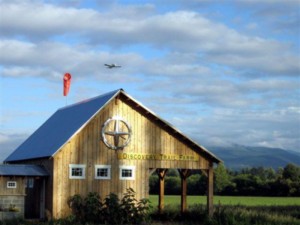
The large pump house built for Discovery Trail Farm uses Craftsman-style architecture similar to design requirements for homes at the airpark.
The Sallee family intends to keep the airport operating indefinitely, but in the case of a sale, legal restrictions are in place requiring any future buyer to maintain the airport as the primary use of the property. When LeRoux approached the family about his residential airpark project, the owners saw an opportunity to enhance the airport as well as protect its long-term viability.
LeRoux, a retired industrial hygiene consultant who has lived in the area for 26 years, has already paved the airpark’s roads and the taxiway. He provided a deep well for spring water, so clean it doesn’t need treatment; built a large pump house; and installed underground utilities that include electricity, telephone and high-speed Internet service.
“Because the development is so unique, we’ve established building restrictions,” LeRoux said. “I’ve seen other airparks, and some of them are a hodgepodge of designs. All of us will quit flying at some time, but no one should feel they have to leave their home because it looks like they’re living in an industrial airpark.”
Buyers in the airpark must design their homes and hangars in the Craftsman style, to provide a common appearance, even though each owner’s buildings will have distinct differences.
“We believe that the hallmarks of that style—knee bracing, shingles, gables, front porches and distinctive window and door trim—are true to the heritage of Discovery Trail Farm and the original farmhouse found in the valley,” LeRoux said. “If you work with one of our preferred architects or builders, the $1,500 design and review fee is waived, because they’re familiar with county regulations and local tradesmen, as well as the climate and ecosystem in Sequim.”
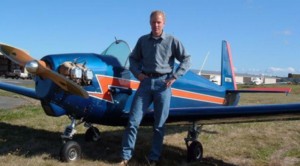
Michael Payne, Port Townsend Aero Museum director of restoration, is a regular commuter from Sequim Valley Airport. He flies his 1950 Mooney Mite the 20 miles to work.
Owners can’t install 24-hour yard lights, and any other lights must shine down and not into neighboring windows, as part of the homeowner association covenants.
“Pilots appreciate not having light glare when they’re landing at night, and out here, we like to see the stars at night and the snowy outline of the Olympic Mountains,” LeRoux said. “You can’t have all of that without controlling lighting sources.”
Paul and Mary Kuntz of Seattle were the first to buy a site at Discovery Trail Farm. Paul, a retired Boeing engineer who now works as a consultant, has begun construction of a 7,000-square-foot home and a 2,600-square-foot hangar to house a plane he’s building. He and his wife spent four years looking at airparks all over the country before discovering LeRoux’s venture.
“We liked the community environment and the concept of open land,” Paul Kuntz said. “The price of the lot is on the high end, but when we looked at the whole package, we were very impressed.”
For more information, visit [http://www.discoverytrailfarm.com] and [http://www.sequimvalleyairport.com].











